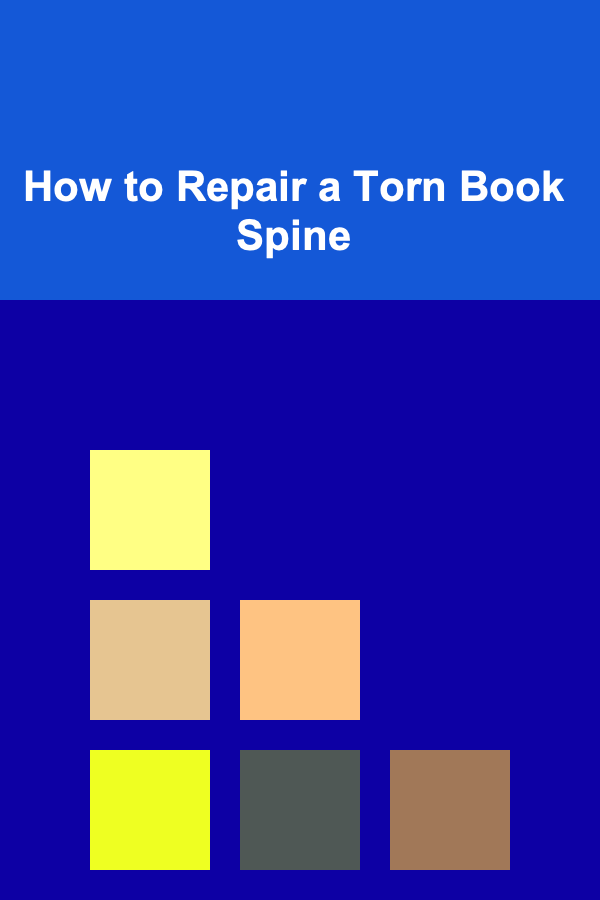
How to Repair a Torn Book Spine
ebook include PDF & Audio bundle (Micro Guide)
$12.99$5.99
Limited Time Offer! Order within the next:

Books are cherished objects that hold memories, knowledge, and stories. Whether it's a beloved novel, a family heirloom, or a treasured textbook, books can easily become damaged with time and use. One of the most common forms of damage is a torn or broken book spine. A torn book spine not only affects the book's aesthetic appeal but can also compromise its structural integrity, making it harder to read and preserve.
Repairing a torn book spine may seem like an overwhelming task, especially for valuable or sentimental books. However, with the right tools, techniques, and a bit of patience, it's possible to restore a torn book spine to its former glory. In this article, we'll take a deep dive into how to repair a torn book spine step by step. By the end, you'll be equipped with the knowledge needed to restore your books to their original condition.
Why Book Spine Damage Occurs
Before we dive into the repair process, it's essential to understand why book spines get damaged in the first place. This will not only help you prevent future damage but also give you an understanding of how to approach the repair in the most effective way.
Frequent Use and Handling
The most common reason for a torn book spine is frequent handling and use. When a book is opened and closed repeatedly, the spine---the area where the pages are bound---takes the brunt of the pressure. Over time, this constant bending can weaken the spine, causing it to tear or crack, especially if the book is made of low-quality materials or poorly bound.
Environmental Factors
Books that are exposed to environmental stressors, such as humidity, temperature fluctuations, and direct sunlight, are also more likely to suffer spine damage. Humidity can cause the glue in the spine binding to weaken, while exposure to light can cause paper to become brittle and fragile.
Poor Storage Conditions
Improper storage conditions can also contribute to spine damage. Storing books in a cramped shelf with other heavy objects can put unnecessary pressure on the spine, especially if the books are forced in or out of the shelf. Books that are stored in damp or high-temperature environments are also more susceptible to spine deterioration.
Assessing the Damage
Before you begin repairing a torn book spine, it's important to assess the damage thoroughly. Is the tear small and contained, or is it a larger break that compromises the structural integrity of the spine? Is the book still holding together, or are pages beginning to detach from the spine? Understanding the extent of the damage will help you decide on the best approach for repairing it.
Minor Tears
Minor tears are those that are relatively small in size (usually a few inches or less) and do not threaten the structural integrity of the book. These can often be repaired relatively easily with basic supplies such as glue and adhesive tape.
Major Tears
A major tear typically involves a larger area of the spine that has cracked or broken, and may cause the pages to become loose or detached. This type of damage will require more advanced techniques and additional materials to ensure the spine is securely reattached.
Detached Pages
If the tear in the spine has caused pages to become loose or detached, this will require a more careful and thorough repair to avoid further damage. In some cases, it may be necessary to rebind the entire book, which is a more advanced form of book restoration.
Tools and Materials Needed
To repair a torn book spine, you'll need a few essential tools and materials. While the specific supplies may vary depending on the severity of the damage, here is a general list of what you'll need to get started:
- PVA Glue (Polyvinyl Acetate Glue): This is a type of bookbinding glue that is flexible, acid-free, and dries clear, making it perfect for book repairs.
- Glue Brush or Small Paintbrush: A brush is ideal for applying glue in precise amounts to the spine.
- Bookbinding Tape: A strong, archival-quality tape that will help reinforce the spine without damaging the book.
- Craft Knife: Useful for trimming excess materials and making precise cuts.
- Clamps or Weights: To hold the book in place while the glue dries.
- Bone Folder or Flat Tool: This tool helps to smooth out the pages and make sure the glue binds evenly.
- Archival Paper or Fabric (Optional): For more advanced repairs or to reinforce the spine.
Having these tools on hand will ensure that you're fully prepared to repair your torn book spine effectively.
Step-by-Step Guide to Repairing a Torn Book Spine
Step 1: Gather Your Materials and Set Up a Workspace
Start by gathering all the necessary materials and setting up a clean, well-lit workspace. Choose a flat, stable surface such as a table or desk where you can work comfortably.
Lay out all the tools and materials you will need. Make sure your book is in a safe, protected area so that it doesn't get exposed to more damage during the repair process.
Step 2: Inspect and Clean the Book
Before you begin the repair, inspect the book carefully for any other signs of damage. Are there any loose pages, bent corners, or torn edges? Take note of these and plan to address them as you repair the spine.
Gently clean the book's surface using a soft, dry cloth. Remove any dust or debris, particularly from the spine area, so that glue can adhere properly.
Step 3: Apply PVA Glue to the Spine
Using your glue brush or small paintbrush, carefully apply a thin layer of PVA glue to the torn area of the spine. Be sure to apply the glue evenly and avoid using too much, as excess glue can seep into the pages and cause further damage.
If the tear is significant, you may need to apply glue along the entire length of the spine to reattach any loose or detached sections. Be mindful not to glue the pages together---focus on gluing just the spine and any torn edges.
Step 4: Align and Press the Spine
Once the glue has been applied, gently press the torn pieces of the spine together, ensuring that the edges align correctly. Use a bone folder or flat tool to smooth out the area and remove any air bubbles or wrinkles.
If the tear is large or the book has multiple breaks, you may need to reinforce the spine with additional materials, such as archival paper or fabric, before gluing. Cut these materials to the appropriate size and apply them over the torn area to create extra support.
Step 5: Secure the Spine and Allow the Glue to Dry
After the torn spine has been realigned and secured, it's time to hold the book in place while the glue dries. Use clamps or heavy weights to apply gentle pressure to the book. Ensure that the spine remains aligned and that no pages shift during the drying process.
Allow the glue to dry for at least 24 hours, or as directed by the manufacturer of your PVA glue. During this time, refrain from opening or handling the book.
Step 6: Reinforce with Bookbinding Tape (Optional)
For added durability, consider using bookbinding tape to reinforce the spine once the glue has dried. Bookbinding tape is especially useful for books that experience frequent handling, as it adds an extra layer of protection to the spine.
Carefully apply a strip of tape along the spine, making sure it covers the torn area completely. Press down gently to ensure good adhesion.
Step 7: Trim and Finish the Repair
Once the glue and tape have dried, carefully trim away any excess glue or tape using a craft knife. Take care to make precise cuts to ensure a clean, finished look.
If the spine appears too bulky due to the repair, you can gently trim it down to match the original dimensions of the book. Use a sharp craft knife and work slowly to avoid damaging the pages.
Step 8: Test the Repair
Once the repair is complete, gently test the book by flipping through the pages. Make sure that the spine feels secure and that the pages turn freely without any signs of further damage. If the repair has been done correctly, the book should feel solid and sturdy.
Preventing Future Spine Damage
Now that you've repaired the torn book spine, it's important to take steps to prevent further damage. Here are a few tips for keeping your books in good condition:
- Store Books Properly: Store books in a cool, dry place away from direct sunlight. Ensure that books are stored upright and are not overcrowded on shelves.
- Handle with Care: Handle books gently, especially when opening them. Avoid forcing the spine open too far, as this can cause stress on the binding.
- Use Protective Covers: For books that are particularly valuable or sentimental, consider using protective book covers to shield them from wear and tear.
Conclusion
Repairing a torn book spine is a delicate yet rewarding process that requires patience and the right materials. By following the steps outlined in this article, you can restore your book and ensure it remains in good condition for years to come. Whether it's a treasured family heirloom or a well-loved novel, a little time and effort can go a long way in preserving the integrity and beauty of your books.
Remember, while repairing a book spine may seem intimidating, it's entirely possible to repair even major tears with the right techniques and materials. With practice, you can become skilled at book repair and enjoy the satisfaction of bringing damaged books back to life.
Reading More From Our Other Websites
- [Organization Tip 101] Affordable Pergola Building Plans for Homeowners on a Budget
- [Personal Care Tips 101] How to Prevent Gingivitis with Toothpaste
- [Personal Investment 101] How to Make the Most of Your Vanguard Personal Pension Investments
- [Home Budget Decorating 101] How to Create a Cozy Living Room with Affordable Decor
- [Home Maintenance 101] How to Care for Your Home's Kitchen Countertops and Backsplash
- [Organization Tip 101] Creative Raised Garden Bed Designs for Small and Large Spaces
- [Tie-Dyeing Tip 101] From T‑Shirts to Home Décor: How to Tie‑Dye Anything in Your Wardrobe
- [Home Soundproofing 101] How to Soundproof Your Home for an Undisturbed Movie Night
- [Personal Care Tips 101] How to Use Sunscreen with Other Skincare Products
- [Polymer Clay Modeling Tip 101] Best Tips for Creating Ultra‑Realistic Polymer Clay Miniature Food Sculptures

How to Create a Simple and Scalable Business Operations Plan
Read More
How to Use Asset Allocation to Optimize Your Investment Portfolio
Read More
How to Use Holiday Decor to Make Your Home Feel Warm and Inviting
Read More
Quality Control Manager's Handbook: Best Practices for Maintaining Consistency and Compliance
Read More
How to Avoid Paying Credit Card Interest Forever
Read More
How to Negotiate Like a Pro: Real Estate Agent Secrets
Read MoreOther Products

How to Create a Simple and Scalable Business Operations Plan
Read More
How to Use Asset Allocation to Optimize Your Investment Portfolio
Read More
How to Use Holiday Decor to Make Your Home Feel Warm and Inviting
Read More
Quality Control Manager's Handbook: Best Practices for Maintaining Consistency and Compliance
Read More
How to Avoid Paying Credit Card Interest Forever
Read More